Cathay Pacific flies cleaner, further with the new A350-1000

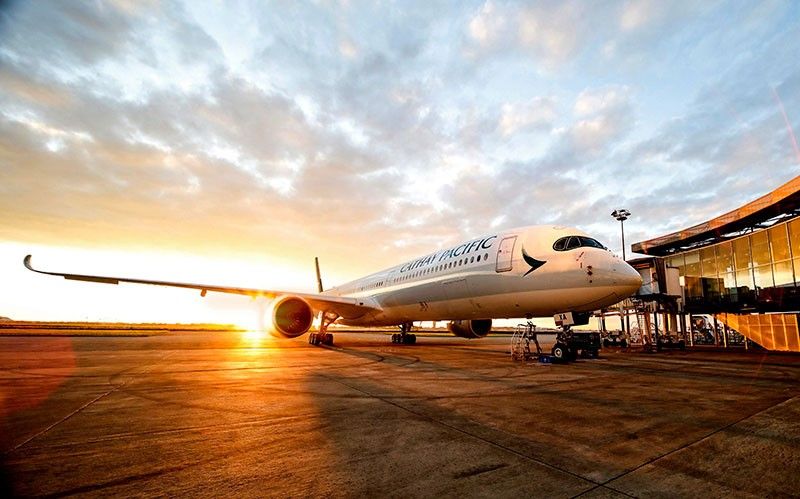
Last Wednesday, Cathay Pacific’s first ever A350-1000 landed in Hong Kong, starting a new generation of modern and clean-fuel aircraft for the airline’s fleet.
An Airbus takes off or lands every 1.4 seconds. By the time you finish reading this story, about 500 will have done that all over the world; in 24 hours, 61,714 Airbus aircraft will have taken off or landed at any given airport on the map.
There’s a little bit of poetry in these numbers — one imagines airplanes carrying people home or taking them to adventures that lie ahead; the anticipation of a long-overdue homecoming, a reunion, or simply a weekend away to some island or a new city. Every single takeoff or landing is the beginning of a story for millions of people every day.
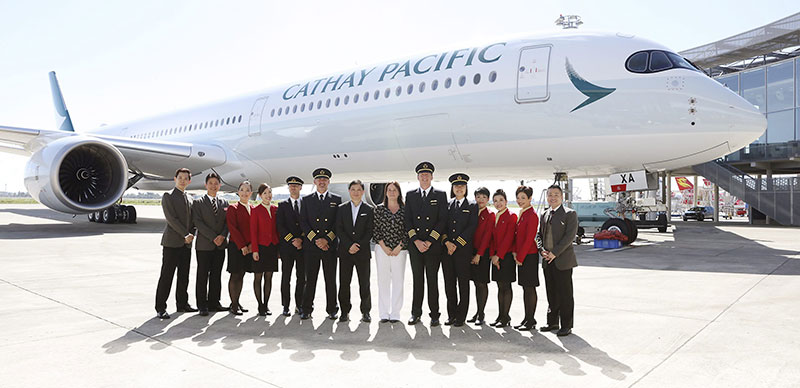
Cathay Pacific chief customer and commercial officer Paul Loo, flight operations director Anna Thompson, the four pilots who flew the A350-1000 from Toulouse to Hong Kong Evan Summerfield, Karl Lucas, Marcin Grzyb and Dominica Yung, and the flight crew at the Airbus Delivery Center. CX has 20 more A350-1000s to be delivered until 2021 (the next delivery is in August).
Last Wednesday, an Airbus plane made a special landing in Hong Kong. For the first time in the world, Cathay Pacific’s first ever A350-1000, which took off from Airbus’ runway in Toulouse 12 hours before, landed at Chek Lap Kok International Airport, signaling the start of a new generation of modern and clean-fuel airplanes for the airline’s fleet. It is only the second such plane in the world, and the first in Southeast Asia.
The wide-body aircraft will be used for CX’s longest route in its network: the 17-hour nonstop flight from Hong Kong to Washington, DC, a distance of 8,153 miles (13,122 kilometers). The service begins in September, four times a week, as the airline expands its long-haul network and increases its capacity in its 206 destinations in 52 countries. The A350-1000’s first commercial flight will be to Taipei, and will serve Madrid, Tel Aviv, Amsterdam, Manchester and Zurich from winter this year.
Cathay Pacific chief customer and commercial officer Paul Loo who, six years ago, negotiated the carrier’s order of 20 A350-1000s to be delivered until 2021 (the next delivery is in August), says, “We already have one of the youngest long-haul fleets in the sky (an average of 5.6 years in service), and with the arrival of the A350-1000, our fleet is only going to get younger. The aircraft follows the successful entry of the A350-900 variant, which has enabled us to expand our long-haul network at a near unprecedented rate, providing our customers with a wider range of nonstop travel choices while at the same time strengthening Hong Kong’s position as Asia’s largest international aviation hub.”
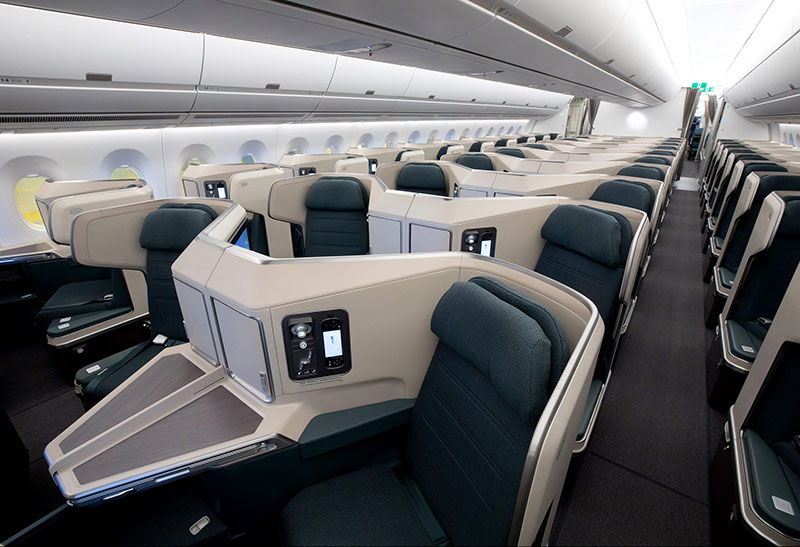
The business class cabin features more comfortable seats that convert into flat beds with one touch, new personal stowage compartment on the side and a touchscreen remote control. Throughout the plane are air and noise management systems and ambient lighting that help passengers relax.
Called “the future of air travel,” the A350-1000 is longer than its 900 sister in the A350 XWB family with 54 more seats (CX’s configuration is from 280 for four-class planes with first, business, premium economy and economy; to 334 for those without first class).
“From now until 2024, we still have 79 aircraft to be delivered in total,” says Loo. Though he wouldn’t say the investment for this particular aircraft, he says the “the total cost of our investment is more than what Hong Kong is spending on building a third runway,” which is HK$141.5.billion (US$18 billion).
Cathay Pacific general manager for corporate affairs Kinto Chan says the airline’s A350 planes are partly powered with biofuel to reduce the airline’s GHG emissions and to fly greener. “Fulcrum Bioenergy will supply the aviation biofuel produced from municipal solid waste.”
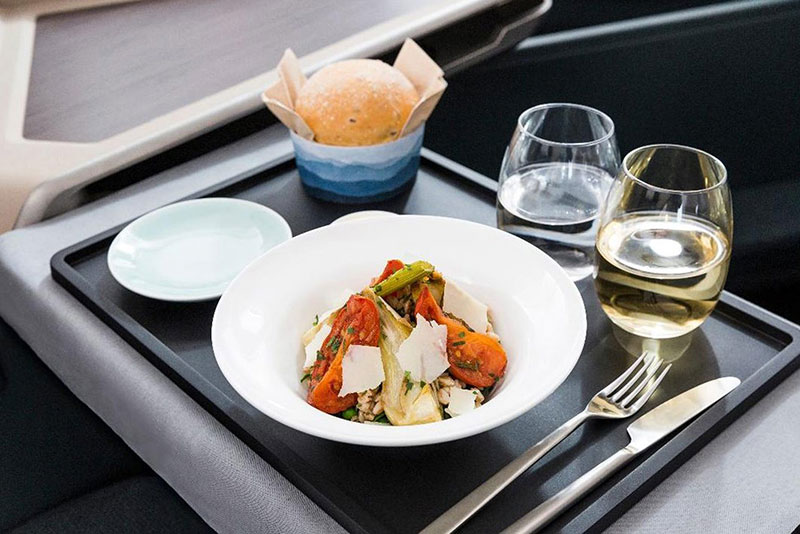
The business class menu has three more starter choices and up to six main course choices.
Airbus head of A350-XWB marketing Marisa Lucas-Ugena says that compared to previous aircraft generation, the A350-1000 is 25 percent better in fuel burn, CO2 emissions, and cash operating cost. “Its new wing, inspired by and acquired from nature, morphs to mimic a bird’s wing; it has a new fuselage design using 70 percent advanced titanium and composite material, which means no corrosion or fatigue, and lower weight and reduced maintenance.”
The A350-1000’s Rolls Royce Trent XWB engine is the world’s most efficient large aero-engine flying today with 1.8 million flying hours and 99.89 percent operational reliability. The aircraft also features simpler systems. In the cockpit, there are six identical touchscreen displays and its fuel systems and fewer pumps or valves means lower maintenance cost.
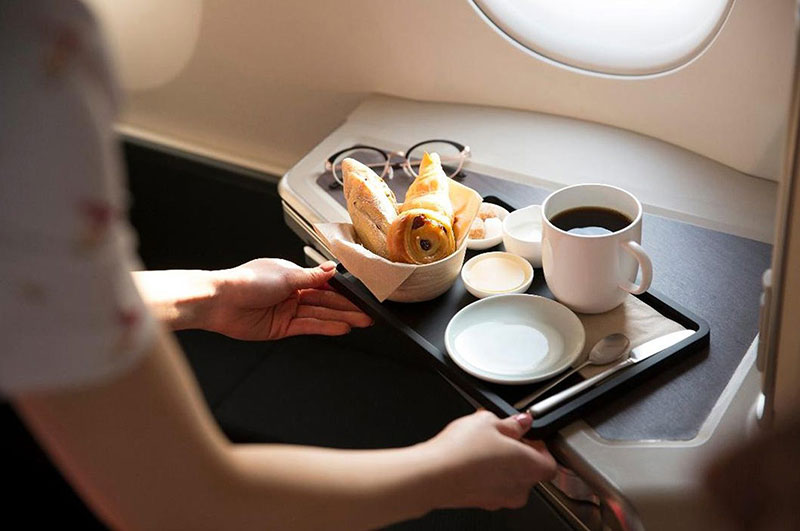
You can also now order your breakfast a la room service before you sleep.
CX 3510 or the ferry flight from Toulouse to Hong Kong had only 76 passengers composed of CX executives, engineers, and employees who had won a company-wide contest held by the airline, and journalists. Out of the 334 seats, only business and premium economy cabins were occupied.
As soon as the seatbelt sign went off, we were up and about inspecting the plane. Being a noncommercial flight, it was unlike any other flight of course. For one, the economy cabin was empty. Second, there was an atmosphere of celebration and for us journalists it was actually the only time we got to exchange business cards on this coverage, having done a series of interviews and tours at the Airbus factory the day before.
And third, the CX executives had loosened up as we were chatting on the aisles — finally, after six years, they were bringing this baby home! CX general manager for planning Lavinia Lau even helped with the breakfast service, serving bread to passengers. “When else can you do this?” she says with a laugh.
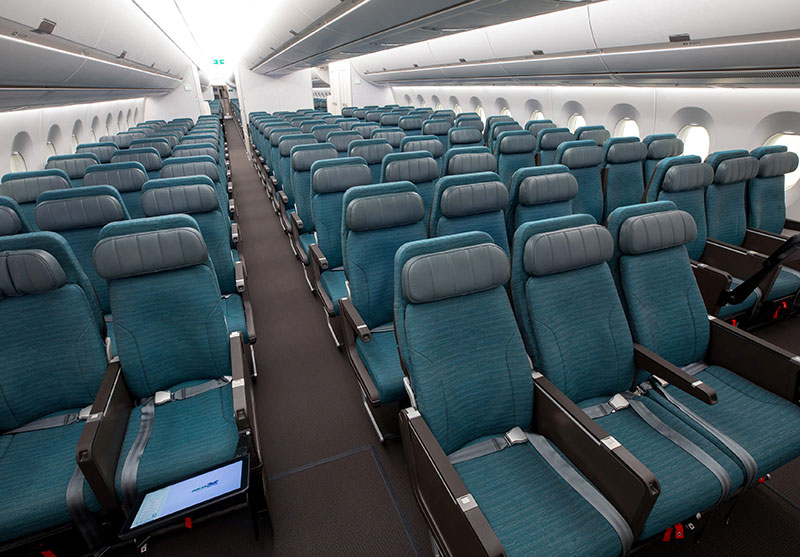
The economy seat’s headrest now feels more like a pillow and it’s adjustable six ways. There is also a new mobile phone holder
Joy Loo, the lovely Filipino wife of CX executive Paul Loo, says, “Obviously, food is not a priority on this flight” as we continued to inspect the new features of the economy cabin almost two hours into the flight.
With all the journalists taking pictures and videos of the crew as they served drinks and food, it took twice the amount of time than on a regular flight. Leslie, a flight attendant who’s been with CX for 22 years, corrects me. “No, thrice!” he says. Indeed, the very cheerful flight attended was very excited to be on the ferry flight. “It’s a privilege for me,” he says. “Every crew wants to experience this and it comes only once in a lifetime.”
Cathay Pacific corporate affairs editor Alexander Jenkins says the airline held a contest among its employees and the winners were flown to Toulouse, had a tour of the Airbus facilities, and joined the delivery flight back to Hong Kong.
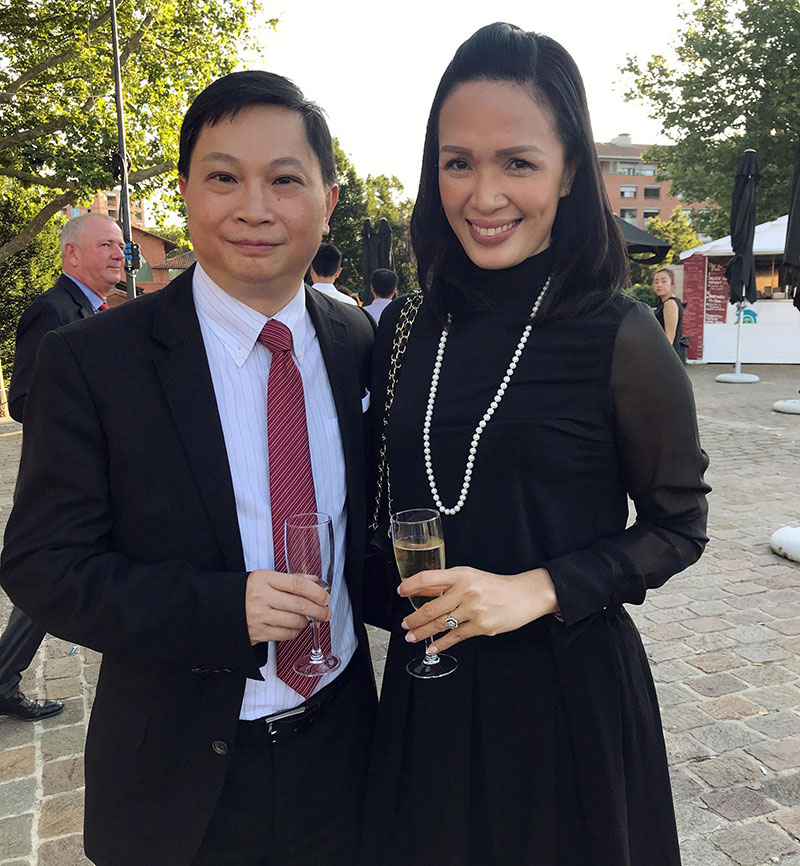
Cathay Pacific chief customer and commercial officer Paul Loo and wife Joy Loo
A brand-new plane is the norm for CX, which is receiving a new one every month as it retires some planes and adds to its existing 206-aircraft fleet — but a new-generation aircraft is a big deal.
It’s not only the hardware that makes the A350-1000 the most efficient aircraft today, it’s also the passenger experience. The cabins have a higher ceiling, a flat floor — no more bumps that cover wires running throughout the plane — wide panoramic windows, HD screens, more legroom, and LED ambient lighting with 16.7 million colors that make possible lighting scenarios to mimic natural sunrise and sunset and help reduce the effects of jet lag. Plus, what everyone wants — mobile and WiFi networks! The latter is especially good news for Filipino travelers who need to work on a long-haul — but who are we kidding? — it’s important to document their air travel on social networks in real time.
On the delivery flight from Toulouse to Hong Kong, we experienced just how intuitive the design is, and how much more comfortable the A350-1000 business class is compared to Boeing’s 777-ER of the same class, which the airline will be replacing in phases. The seat, which converts into a full flat bed, is longer and doesn’t have the bumps that I felt lying down — it felt like a true bed.

CX head of corporate affairs Carolyn Leung and Airbus head of communications Asia-Pacific Sean Lee
Also, there is compartment beside the seat where you can store your handbag and other stuff compared to the net pocket in the 777. When you raise the armrest a water bottle cavity reveals itself so hydration is within easy reach at all times.
As for the entertainment system, the screen is full HD with a touchscreen remote control. Trying to find figure out the device, I was prompted, “Do you want to watch movie on this screen or main screen?” It means you can have one movie playing on your PTV and another one on your handheld screen.
I mention this to Paul Loo and he says, “It makes sense because when you’re lying down you don’t want to be looking at the big screen but want to watch movies closer to you.”
In the economy seats, the headrest has been redesigned with a softer, leather- overed one that’s adjustable six ways, and it feels like a pillow now. There is also a mobile phone holder for when you want to watch movies on your phone or just a place to put it while you’re charging on the USB socket, and a cup holder. They’ve added a metal stepper on the aisle seat for you to reach the luggage stowage (the plane has a higher ceiling).

CX general manager for planning Lavinia Lau
“Have you noticed that it’s quieter than on other flights? Sometimes on older planes, I can’t talk to my wife, but here that’s not a problem,” says Loo.
“It’s nine decibels quieter than the 777-ER,” Airbus’ Marisa Lucas-Ugena, who incidentally started her career at Boeing, told us the day before.
According to Airbus, “the air management systems help passengers to enjoy a more relaxing flight. Total cabin air is renewed every two to three minutes in a draft-free environment at the optimum temperature and with 20 percent more fresh air. In addition the A350 offers the unique possibility to install an active humidification system in business and first class to reproduce a private jet flying experience.”
Lucas-Ugena adds, “There are features on this aircraft that you cannot see but you can feel. And on a long-haul flight, you will feel better when you land.”

CX general manager for corporate affairs Kinto Chan
* * *
Visit the author’s travel blog at www.findingmyway.net. Follow her on Twitter and Instagram @iamtanyalara.
Cathay Pacific flies from Manila to Hong Kong seven times a day to connect you to any of CX’s 206 destinations in 52 countries; 12 times a week from Cebu, and four times a week from Clark on Cathay Dragon. Starting in October, Cathay Dragon will have four times a week direct flights from Davao City to Hong Kong. Call the global center at +180014411011 for Smart/PLDT, +180087395117 for Globe. Log on to www.cathaypacific.com.



















